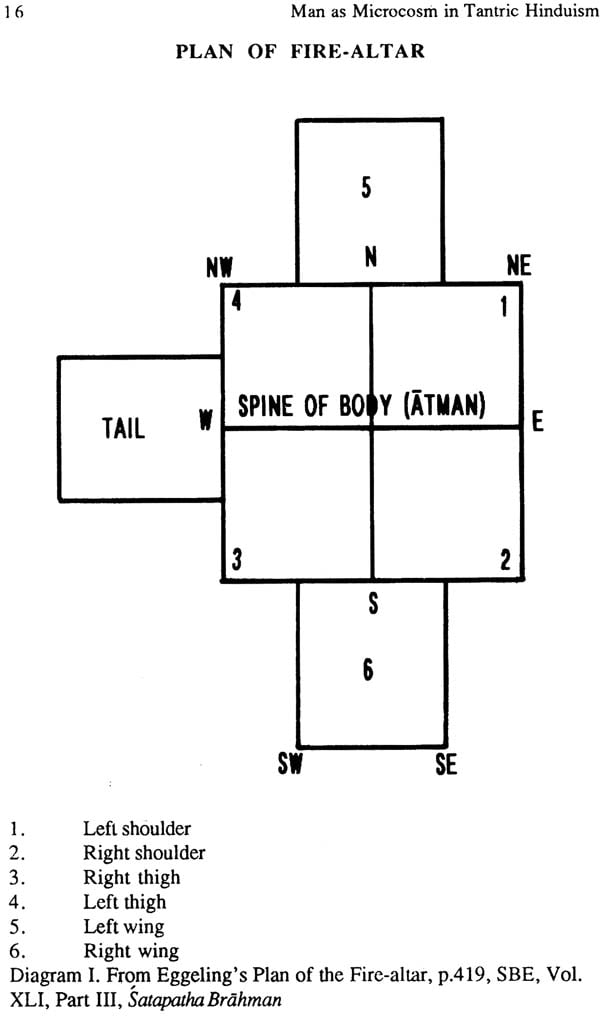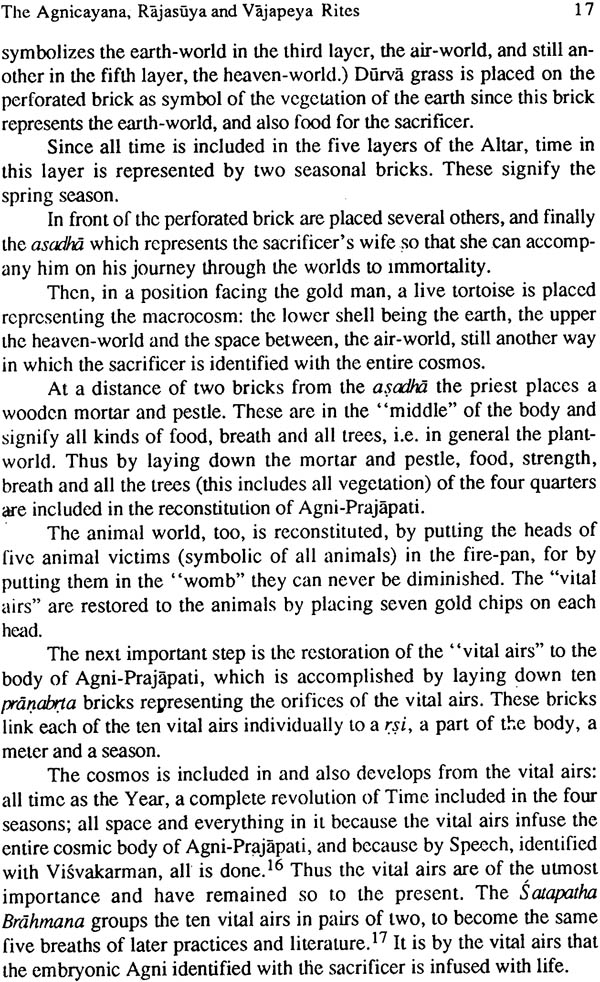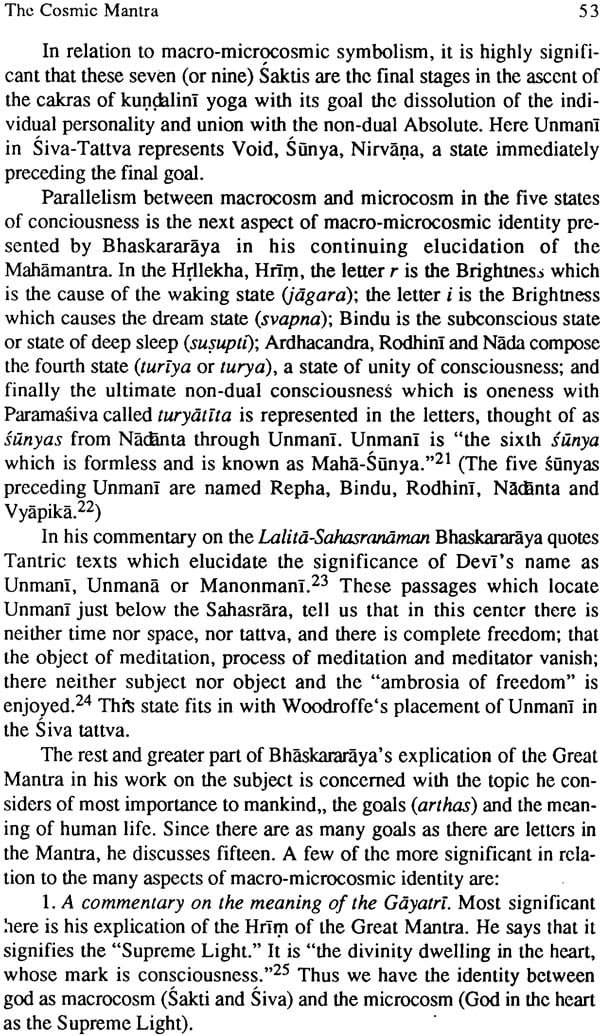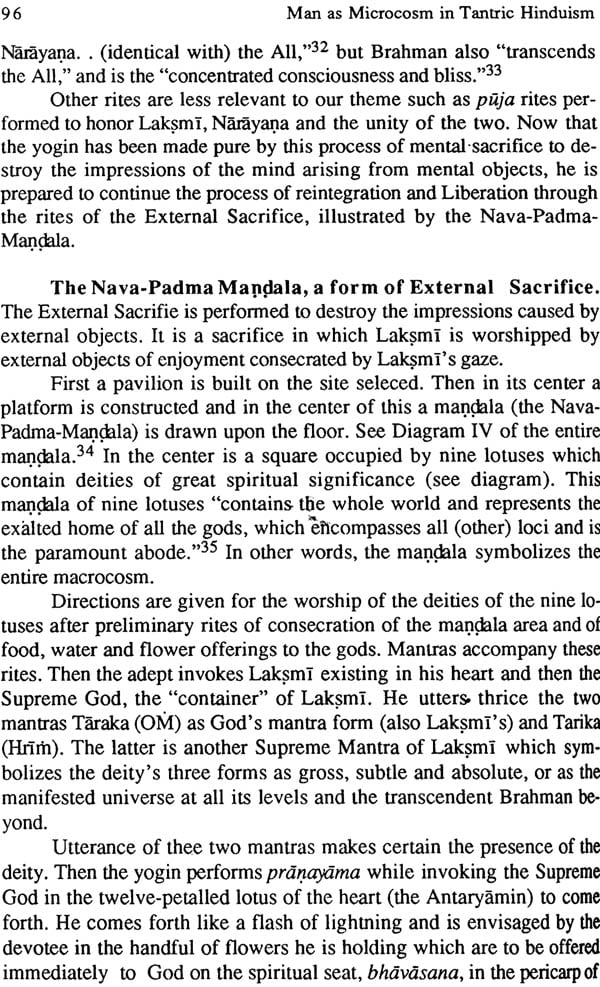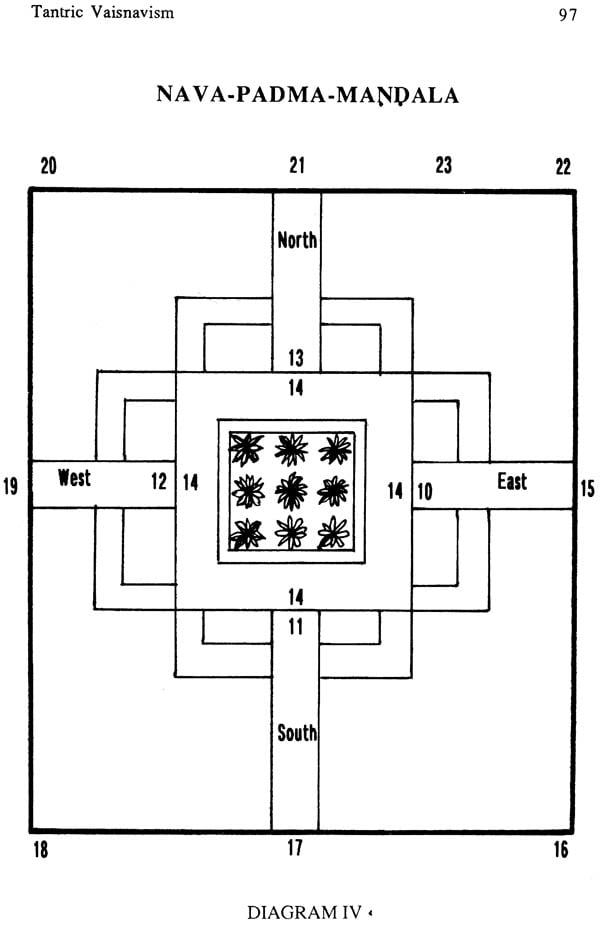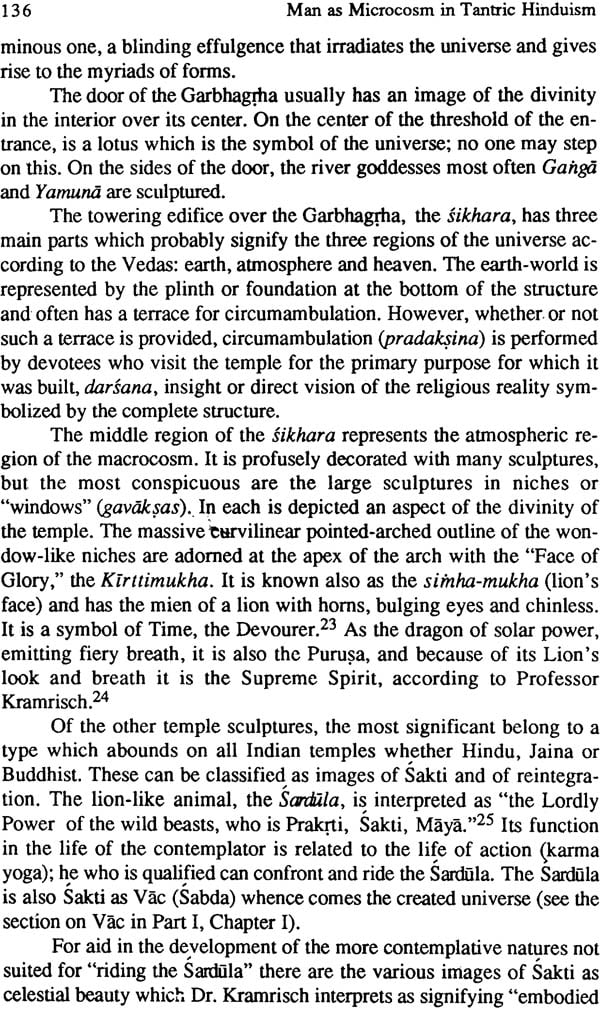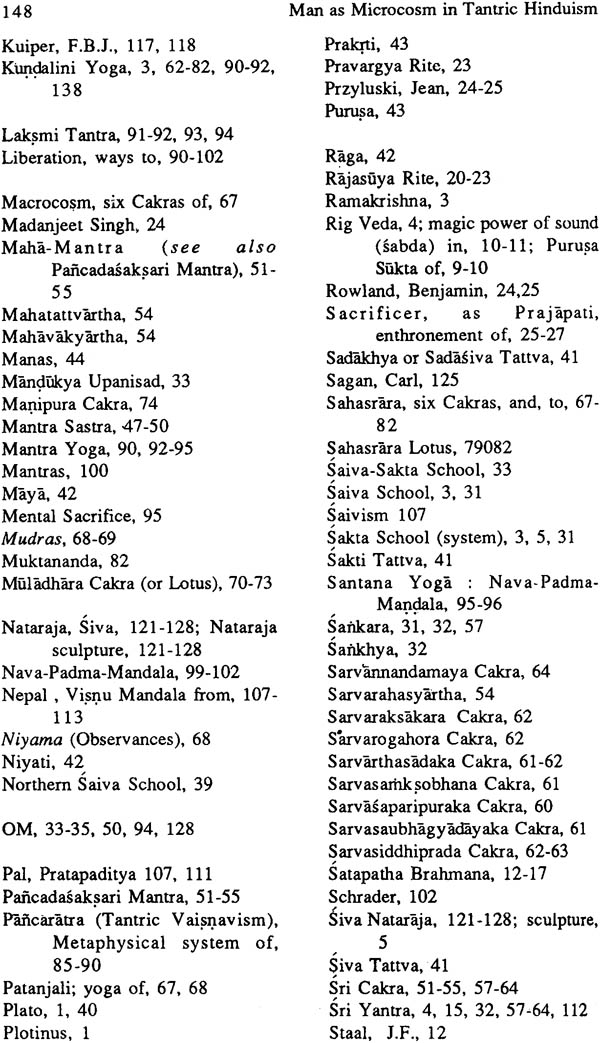
Man as Microcosm in Tantric Hinduism (An Old Book)
Book Specification
| Item Code: | NAM994 |
| Author: | Grace E. Cairns |
| Publisher: | Manohar Publishers and Distributors |
| Language: | English |
| Edition: | 2005 |
| ISBN: | 9788173046575 |
| Pages: | 156 (9 B/W Illustrations) |
| Cover: | Paperback |
| Other Details | 8.5 inch X 5.5 inch |
| Weight | 190 gm |
Book Description
Among the traditional philosophies and schools of Hinduism the idea of the identity between macrocosm and microcosm is prominent in classical Advaita Vedanta as well as in the more philosophical aspects of Tantric Hindusim; for it is here that we find the most significant thought, symbolism and rituals that have given rise to great works of art as in the examples of painting, sculpture and architecture used as illustration in the text.
The most outstanding feature of the Tantric system is the use of yantra, mantra and especially kundalini yoga. It is shown clearly how a great yantra, great mantra and kundalini yoga are related to the realization of macro-microcosmic identity, man’s goal.
This book should provide the student interested in Indian culture with greater depth in the more popular Tantric cults than the usual texts on Indian religions. It should be especially helpful in the understanding of the ritual practices of yantra, mantra and kundalini yoga in relation to liberation and to Indian art. The examples given of Indian art depict this relationship.
Grace Cairns is Professor Emeritus of Philosophy and Religion at the Florida State University, Tallahassee, Florida, U.S.A. she is author of Philosophies of History (Greenwood Press, Westport, Connecticut, 1971). She is co-author of Religions of the World with S.V. McCasland and David Yu (Random House, New York, 1969). She has also published numerous in scholarly journals and chapters in books.
In western culture ideas of an identity between macrocosm and microcosm are as old as Biblical literature. In the Old Testament, it is said that man was originally made in the image of God but lost his divine attributes through sin. In the New Testament, Redemption came through Jesus the Christ who was both human and divine-as divine, being one of the three in the Trinity, which comprises the Father (God), the Son (Christ) and another member, the Holy Spirit, which dwells within every man. Thus man may also be called partly divine through not identical with the macrocosmic reality. Yet Christian mystics from early Christian times have been close to affirming oneness with God, as heirs of the Nee-Platonic philosophy that stemmed from Plotinus and Scotus Erigena, his translator. Plotinus, himself, like the seers of the great Upanisads experienced an absolute identity between himself and the One, the macrocosmic divine reality. Professor Wayman in his article, "The Human Body as Microcosm" shows how notions of macro-microcosmic identities were developed by outstanding western thinkers beginning with Plato, and continuing through such men as Jacob Boehme and other sixteenth century thinkers and how these were also developed in geometry and number symbolism.
Today scientific thought has become ascendant in the West. Does this mean that all ideas of macro-microcosmic symbolism must be abandoned? Our scientific knowledge, though still meagre at this point in man's youthful history, tells us that the matter of our bodies is the same as that found in the stars, our biological qualities similar to all other life forms, and our mental abilities akin to those of other higher animal forms. Yet our self-conscious awareness elevates us over other animals. In man, the cosmos has attained self-consciousness as it has also attained perhaps on other planets in this vast universe. This self- consciousness is called 'spirit' by many and likened to the Divine or God. The great mystics of East and West seem to have experienced a still higher form of consciousness; a super conscious state of oneness with the Ground, the Source of Being, the eternal spiritual Center that transcends yet is immanent in the concrete universe. In this state of oneness with the one, there is similarity, if not identity between macrocosm and microcosm. Man is seen not only as including all levels of the hierarchy of existence in the temporal world but transcending these in the super conscious state, the eternal immortal bliss.
Now, if there is such a spiritual reality, it should reveal itself also as unity in the natural world. In the realm of physics, Einstein sought a unification theory that would integrate the four basic forces of nature: the electro-magnetic, the weak force, the strong force and gravity. Experiments have been set up to investigate gravity waves, which is a long step towards integrating gravity into already existing unification theories that have successfully integrated the other three forces. Most recently, Stephen Hawkins, often called our contemporary Einstein, has made significant progress towards perfecting such a theory. It seems the Grand Unification Theory will be realized before our century ends, and nature will be seen as one grand unity of which we are a part.
Along with this search for harmony and unity in the physical world, an outstanding thinker in biology Pere Teilhard de Chardin, sees nature as a progressive evolutionary process from the world of matter to the biological and then the mind level which he calls the noosphere. Eventually the highest level will be reached, the ultra-hominisation of man into virtually a new species. The consciousness of this new being will include the entire cosmos and will have such complete control over the material and biological levels of being, that it will be able to break away from all temporal-spatial limitations and immortality will have been attained.
Along with progression towards this state, a new social order will also have been achieved because attainment of this new Divine state comes about through unity among men based upon mutual love. Pere Teilhard points out that the great mystics have already attained this kind of egoless love for all that will become universal with the advent of the new species. God will be "all in everyone."
Although Pere Teilhard does not posit an identity between macrocosm and microcosm, he presumes that nature has been made in such a way that its processes lead to the divinity of man, so that he finally becomes an image of God.
In Indian thought, Sri Aurobindo has a similar view of man's evolutionary history and goal. He thinks of nature as a process of involution and evolution of the Divine, the Macrocosm, of Spirit. In its evolution, it rises from inconscient Matter to the biological level, Life, then to the mental stage, Mind, and ultimately reaches the highest kind of being, Spirit, the infinite Self. When this evolutionary goal is universally attained, every-one will have reached a state similar to the highest yogic experience, the level which Aurobindo calls the Gnostic, Supermind, the Superman or Supramental.
Spirit will now see itself both as one and many, because the Gnostic Being will know itself both as one and many, as center for concrete action and creativity of the Infinite Spirit. Since each human "Center" will know both the Infinite and all other centers with Gnostic knowledge-by-identity, there will be no overlapping or conflict in creative activities. Thus a new divine life will dawn in the world along with a new social order in which the good of each is the good of all, since each will realize completely his identity with all, a society similar to Pere Teilhard's conception.
Spiritually gifted individuals do not need to postpone this experience of Divinity until mankind universally attains it. Man already has the levels of Spirit within him along with the other three lower levels. In other words, man is a microcosm and his goal is to realize this. Aurobindo's macrocosmic evolutionary process of realization of the level of Spirit is paralleled in man in the process of the ascent of the cakras of kundalini yoga. In this process, kundalinl (identified with the yogin) "passes from an involution in inconscience through a series of opening glories of her powers into the eternal super conscience of the spirit.”
Kundalini yoga is the yoga par excellence of the Sakta and Saiva schools of Hindu Tantrism, but their philosophy maintains, unlike Aurobindo's, an absorption of the yogin into the Brahman with no difference between the two, whereas Aurobindo does not think that the individual spirits are absorbed into the one, but are instead "poises of being" for the Divine creativity though with full conscious unity with It. Therefore in the, former, there is not as much concern with social and political activity to attain a paradise in this world as in Aurobindo's thought. Nevertheless, great Hindu mystics such as Ramakrishna who, like the Saiva and Sakta Tantrics, thought man should seek the ultimate goal of absolute oneness with the Divine, taught that service to man was a cardinal moral principle. This is because a philosophy based upon the identity between macrocosm and microcosm also affirms the identity of man with man as an essential corollary.
We have begun our study of the identity between macrocosm and microcosm in Tantric Hinduism with a brief background of how the idea evolved and developed in Hindu thought. We find its beginnings in the hymns of the Rig Veda, most obviously in the Purusa Sukta (Rig Veda X.90) wherein the author derives the universe from the Purusa a gigantic Person sacrificed by the gods to form all the multiple forms of the universe. Yet the Purusa also has a transcendent aspect since only one-fourth of his being is the manifested universe; three-fourths of Him is the Immortal in Heaven.
The next stage of development is found in the Brahmanas. The Satapatha Brahrmana's account of the Fire-Altar ritual shows that the Purusa of the Purusa Sukta has now become the god, Prajapati, ritually sacrificed to recreate the universe every year. The human sacrificer through performance of the ritual, becomes a microcosm through identification with Prajapati, the macrocosm, the universe. Such identification wins the sacrificer immortality in Heaven. Other rituals in the Satapatha Brahmana such as the Rajasuya and Vajapeya similarly identify the sacrificer as microcosm with the macrocosmic reality for the attainment of immortality in heaven.
A more profound approach to the nature of immortality was set forth by the sages of the great Upanisads. In this literature in the monistic Upanisads, the material and spiritual center of the universe is the One, the Brahman, who is the Source of the entire universe and one with man as microcosm.
Systematic formulations were given to this idea of identity in later philosophical systems such as the Advaita Vedanta and in the more popular Tantric systems. Since it is the latter that are richer in symbolism and therefore more influential in the arts, we have limited ourselves to them with only passing reference to other systems.
The outstanding feature of the Tantric systems is the use of yantra, mantra and kundalini yoga to attain identity of the yogin with the One, the Macrocosm. Since the greatest yantra of Hinduism is the Sri Yantra, we shall show how it portrays the entire macrocosm to demonstrate to the practitioner his identity as microcosm with It. Through meditation upon this symbol and by using yoga techniques, it is possible for the practitioner to realize his identity with the Ultimate Reality. The form of yoga used is kundalini. During the processes of this discipline, all elements of the entire manifested universe, the macrocosm, are seen and experienced as residing in the microcosm, the individual, who absorbs the plurality of the many into the One, the eternal infinite Brahman, just as the One absorbs the multiplicity of Its created parts into Itself at the end of each cosmic cycle (kalpa). The yogin who has this experience sees all men and all nature as part of himself since all are phenomena of the One. Thus the aspirant attains complete reintegration with man and the cosmos and Liberation from the birth-death cycle, a common goal in most Indian philosophies.
Mantras, another basic aspect of Tantric systems, also play an important role in yoga, in most yantras and in Hinduism generally; but mantra in itself can portray the identity between macrocosm and microcosm and be a primal means to reintegration and Liberation when its goal is the experience of the adept's identity with the one. This is true of the Pancadasaksari mantra, a prime example in the Sakta system, and of the examples given of significant Vaisnava mantras in our treatment of Tantric Vaisnavism.
As we said, Tantric philosophies have been most influential in the arts of India. The Hindu temple is in plan a yantra that manifests the identity between macrocosm and microcosm as in the Fire-Altar built in the Agnicayana rite. In meditative cirumambulation of the temple, the pilgrim perceives it as a symbol in his own reintegration if he is aware of its meaning.
Certain sculptures, for example, the Siva Nataraja and Vaisnava sculptures treated in the text, also symbolize an identity between the macrocosm and the microcosm. These works, like the temple, are aids in the devotees' reintegration with the Ultimate Reality. Certain Hindu paintings have a similar function. We have chosen the Dance of Knit and Visnu Mandala as among the more interesting.
To summarize, the basic function of such works of art, like the cosmic yantras and mantras is the portrayal of cosmic Reality in such a way that the aspirant sees the identity between it and the microcosm within himself. The Katha Upanisad expresses this identity in the oft- quoted passage:
Whatever is here [i.e., in the microcosm] that is there, [i.e., in the macrocosm].
What is there, that again is here.
As Woodroffe says, "The fundamental principle of the Tantra Shastra" is "that man is a microcosm. Whatever exists in the outer world exists in him. Thus when in meditation the aspirant merges into the One, the Light Itself, he can say with Aurobindo:
While there one can be wider than the world
While there one is one’s own infinity.
| Introduction | 1 | |
| Part I | The Vedic Background | 7 |
| I | Aspects of Macro-microcosmic Symbolism in the hymns of the Rig-Veda: Macro-micro Homologisms and the Power of the Sound | 9 |
| II | Macro-microcosmic Symbolism in the Satapatha Brahmana: The Agnicayana and Vajapeya Rites | 12 |
| III | Macro-microcosmic identily in the Upanisads: Ideal and Dumbols | 29 |
| Part II | Man as Microcosm in Tantric Thought, Ritual and Symbolism | 37 |
| IV | Metaphysics of the Sakta and Northern Saiva Schools Tantric Thought | 39 |
| V | The Cosmic Mantra: The Pancadasakari Mantra | 47 |
| VI | The Sri Yantra | 57 |
| VII | Kundalini Yoga and Macro-microcosmic Identity | 66 |
| VIII | Tantric Vaisnavism: Symbols of Likeness between Macrocosm and Microcosm in Yoga, Mantra and Yantra | 85 |
| Part III | Symbols of Identity Between Macrocosm and Microcosm in Hindu Art: Painting, Sculpture and Architecture | 105 |
| IX | Painting: A Vishnu Mandala from Nepal | 107 |
| X | Painting: Kali and the Garland of Letters | 114 |
| XI | Sculpture: The Trivikrama from of Visnu | 117 |
| XII | Sculpture: Macrocosm and Microcosm in the Siva Nataraja | 121 |
| XIII | Architecture: Macrocosm and Microcosm in the Hindu Temple | 130 |
| Bibliography | 141 |
